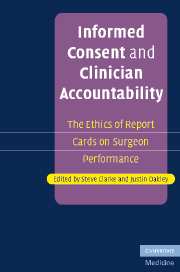Book contents
- Frontmatter
- Contents
- List of contributors
- Acknowledgements
- Introduction: Accountability, informed consent and clinician performance information
- Part I Accountability
- Part II Informed consent
- Part III Reporting performance information
- Part introduction
- 13 Is the reporting of an individual surgeon's clinical performance doing more harm than good for patient care?
- 14 Examining the link between publicly reporting healthcare quality and quality improvement
- 15 Hospital and clinician performance data: what it can and cannot tell us
- 16 An ethical analysis of the defensive surgery objection to individual surgeon report cards
- 17 Surgeon report cards and the concept of defensive medicine
- 18 Training, innovation and surgeons' report cards
- 19 Doctors' report cards: a legal perspective
- Index
- References
13 - Is the reporting of an individual surgeon's clinical performance doing more harm than good for patient care?
Published online by Cambridge University Press: 08 August 2009
- Frontmatter
- Contents
- List of contributors
- Acknowledgements
- Introduction: Accountability, informed consent and clinician performance information
- Part I Accountability
- Part II Informed consent
- Part III Reporting performance information
- Part introduction
- 13 Is the reporting of an individual surgeon's clinical performance doing more harm than good for patient care?
- 14 Examining the link between publicly reporting healthcare quality and quality improvement
- 15 Hospital and clinician performance data: what it can and cannot tell us
- 16 An ethical analysis of the defensive surgery objection to individual surgeon report cards
- 17 Surgeon report cards and the concept of defensive medicine
- 18 Training, innovation and surgeons' report cards
- 19 Doctors' report cards: a legal perspective
- Index
- References
Summary
Introduction
Report cards, also known as league tables, allow publication of outcome data that can reflect the performance of a particular hospital, clinical unit, or an individual doctor. Increasing interest is being focused on clinical report cards, particularly on their use in monitoring the performance of individual doctors and in making that data public. Report cards do have a number of possible roles including self-audit, accountability and to demonstrate safety and industry regulation. Almost 10 per cent of Australia's Gross National Product is devoted to healthcare, so it is an extremely important sector of government (www.aihw.gov.au). Other industries spending this level of tax payers' funds are accountable to the community and it certainly seems appropriate that healthcare is also kept under scrutiny. However, how far should that scrutiny extend and in what form should outcomes be made available to the community? Should the outcomes of individual doctors be made available or should this level of outcome data be retained within the craft groups for self-regulation and audit, leaving unit-based and hospital-based data available for publication and dissemination to the public. What other industries are subject to public distribution of the results of individuals within that industry?
In this chapter we explore the issue of report cards, specifically with regard to cardiac surgeons, who are currently at the forefront of this debate.
- Type
- Chapter
- Information
- Informed Consent and Clinician AccountabilityThe Ethics of Report Cards on Surgeon Performance, pp. 197 - 211Publisher: Cambridge University PressPrint publication year: 2007



